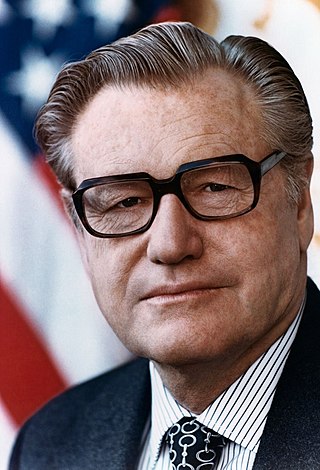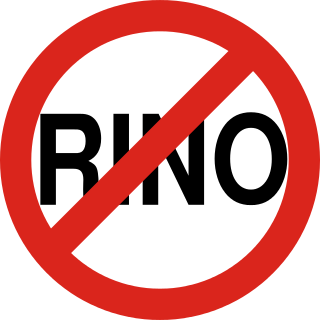Conservatism is a cultural, social, and political philosophy and ideology, which seeks to promote and preserve traditional institutions, customs, and values. The central tenets of conservatism may vary in relation to the culture and civilization in which it appears. In Western culture, depending on the particular nation, conservatives seek to promote a range of institutions, such as the nuclear family, organized religion, the military, the nation-state, property rights, rule of law, aristocracy, and monarchy. Conservatives tend to favour institutions and practices that guarantee social order and historical continuity.

The 1912 United States presidential election was the 32nd quadrennial presidential election, held on Tuesday, November 5, 1912. Democratic Governor Woodrow Wilson of New Jersey unseated incumbent Republican President William Howard Taft while defeating former President Theodore Roosevelt and Socialist Party nominee Eugene V. Debs.

The 1964 United States presidential election was the 45th quadrennial presidential election. It was held on Tuesday, November 3, 1964. Incumbent Democratic President Lyndon B. Johnson defeated Senator Barry Goldwater, the Republican nominee, in a landslide. Johnson was the fourth and most recent vice-president to ascend to the presidency following the death of his predecessor and to win a full term in his own right. With 61.1% of the popular vote, Lyndon B. Johnson won the largest share of the popular vote for the Democratic Party in history, and the highest for any candidate since the advent of widespread popular elections in 1824.
American electoral politics have been dominated by successive pairs of major political parties since shortly after the founding of the republic of the United States. Since the 1850s, the two largest political parties have been the Democratic Party and the Republican Party—which together have won every United States presidential election since 1852 and controlled the United States Congress since at least 1856. Despite keeping the same names, the two parties have evolved in terms of ideologies, positions, and support bases over their long lifespans, in response to social, cultural, and economic developments—the Democratic Party being the left-of-center party since the time of the New Deal, and the Republican Party now being the right-of-center party.

The Rockefeller Republicans were members of the United States Republican Party (GOP) in the 1930s–1970s who held moderate-to-liberal views on domestic issues, similar to those of Nelson Rockefeller, Governor of New York (1959–1973) and Vice President of the U.S. (1974–1977). Rockefeller Republicans were most common in the Northeast and the industrial Midwestern states, while they were rare in the South and the West.
A Red Tory is an adherent of a centre-right or paternalistic-conservative political philosophy derived from the Tory tradition, most predominantly in Canada but also in the United Kingdom where it is more commonly known as one nation conservatism. This philosophy tends to favour communitarian social policies, while maintaining a degree of fiscal discipline and a respect of social and political order. It is contrasted with "Blue Tory" or "High Tory". Some Red Tories view themselves as small-c conservatives.

In US politics, Republican in Name Only is a pejorative used to describe politicians of the Republican Party deemed insufficiently loyal to the party, or misaligned with the party's ideology. Similar terms have been used since the early 1900s. The acronym RINO became popular in the 1990s, and both the acronym and the full spelling have become commonly used by former president Donald Trump and his supporters to refer to his critics within the Republican Party.

The 1938 United States House of Representatives elections was an election for the United States House of Representatives were elections for the United States House of Representatives to elect members to serve in the 76th United States Congress. They were held for the most part on November 8, 1938, while Maine held theirs on September 12. They occurred in the middle of President Franklin D. Roosevelt's second term. Roosevelt's Democratic Party lost a net of 72 seats to the Republican Party, who also picked up seats from minor Progressive and Farmer–Labor Parties.
The Republican Party in the United States includes several factions, or wings. During the 19th century, Republican factions included the Half-Breeds, who supported civil service reform; the Radical Republicans, who advocated the immediate and total abolition of slavery, and later advocated civil rights for freed slaves during the Reconstruction era; and the Stalwarts, who supported machine politics.
Centre-right politics lean to the right of the political spectrum, but are closer to the centre. Parties of the centre-right generally support liberal democracy, capitalism, the market economy, private property rights, and a modest welfare state. They support conservatism and economic liberalism and oppose socialism and communism.
The Old Right is an informal designation used for a branch of American conservatism that was most prominent from 1910 to the mid-1950s, but never became an organized movement. Most members were Republicans, although there was a conservative Democratic element based largely in the Southern United States. They are termed the "Old Right" to distinguish them from their New Right successors who came to prominence in the 1960s, 1970s and 1980s.
The conservative coalition, founded in 1937, was an unofficial alliance of members of the United States Congress which brought together the conservative wings of the Republican and Democratic parties to oppose President Franklin Delano Roosevelt's New Deal. In addition to Roosevelt, the conservative coalition dominated Congress for four presidencies, blocking legislation proposed by Roosevelt and his successors. By 1937, the conservatives were the largest faction in the Republican Party which had opposed the New Deal in some form since 1933. Despite Roosevelt being a Democrat himself, his party did not universally support the New Deal agenda in Congress. Democrats who opposed Roosevelt's policies tended to hold conservative views, and allied with conservative Republicans. These Democrats were mostly located in the South. According to James T. Patterson: "By and large the congressional conservatives agreed in opposing the spread of federal power and bureaucracy, in denouncing deficit spending, in criticizing industrial labor unions, and in excoriating most welfare programs. They sought to 'conserve' an America which they believed to have existed before 1933."
These are the references for further information regarding the history of the Republican Party in the U.S. since 1854.

The Republican Party, also known as the GOP, is one of the two major political parties in the United States. It is the second-oldest extant political party in the United States after its main political rival, the Democratic Party.
The Democratic Party of the United States is a big tent party composed of various factions. The liberal faction supports modern liberalism and social liberalism that began with the New Deal in the 1930s and continued with both the New Frontier and Great Society in the 1960s. The moderate faction supports Third Way politics that includes center-left social policies and centrist fiscal policies. The progressive faction supports social democracy and left-wing populism.
LGBT conservatism refers to LGBT individuals with conservative political views. It is an umbrella term used for what is bifurcated into two specific sub-categories, each with its own term and meaning. The first sub-categorical term, Pre-Stonewall LGBT Conservatism, refers to LGBT individuals embracing and promoting the ideology of a traditional conservatism in either a general or specifically-LGBT social context or environment. The second sub-categorical term, Post-Stonewall LGBT Conservatism, refers to self-affirming LGBT persons with fiscally, culturally, and politically conservative views. These post-Stonewall conservatives' social views, though generally conservative too, at the same time reflect a self-determination-stemmed and more recent socio-historical "gay-affirmation" on issues like marriage equality for same-sex couples, gay family recognition, civic equality generally for LGBT people in society, and also a positive role for (gay-affirming) religion in LGBT life, though there is not complete unanimity of opinion among them on all issues, especially those regarding the dynamics and politics of the closet and "identity management," and various legal and political issues The first term can include LGBT people who are opposed to same-sex marriage or other LGBTQ rights while the second term, contrastingly, usually refers to self-affirming gay people who unequivocally favor marriage as a legal institution for both heterosexuals and gays and who simultaneously prefer economic and political conservatism more generally. The number of self-affirming LGBT advocates for conservative ideas and policies became more apparent only after the advent of the modern LGBT civil rights movement in the 1970s even as many gay conservatives, labelled as "self-hating" at the time, did remain closeted in areas where anti-gay socially conservative politicians then led the most organized opposition to LGBT rights. The Realpolitik and ideology situations for LGBT conservatives today vary by their own self-definition, and each country's sociopolitical, cultural, and legal LGBT rights landscape.
Paternalistic conservatism is a strand of conservatism which reflects the belief that societies exist and develop organically and that members within them have obligations towards each other. There is particular emphasis on the paternalistic obligation, referencing the feudal concept of noblesse oblige, of those who are privileged and wealthy to the poorer parts of society. Consistent with principles such as duty, hierarchy, and organicism, it can be seen as an outgrowth of traditionalist conservatism. Paternalistic conservatives do not support the individual or the state in principle but are instead prepared to support either or recommend a balance between the two depending on what is most practical.
Conservatism in the United Kingdom is related to its counterparts in other Western nations, but has a distinct tradition and has encompassed a wide range of theories over the decades of conservatism. The Conservative Party, which forms the mainstream right-wing party in Britain, has developed many different internal factions and ideologies.

This timeline of modern American conservatism lists important events, developments and occurrences which have significantly affected conservatism in the United States. With the decline of the conservative wing of the Democratic Party after 1960, the movement is most closely associated with the Republican Party (GOP). Economic conservatives favor less government regulation, lower taxes and weaker labor unions while social conservatives focus on moral issues and neoconservatives focus on democracy worldwide. Conservatives generally distrust the United Nations and Europe and apart from the libertarian wing favor a strong military and give enthusiastic support to Israel.
There has never been a national political party in the United States called the Conservative Party. All major American political parties support republicanism and the basic classical liberal ideals on which the country was founded in 1776, emphasizing liberty, the pursuit of happiness, the rule of law, the consent of the governed, opposition to aristocracy and fear of corruption, coupled with equal rights before the law. Political divisions inside the United States often seemed minor or trivial to Europeans, where the divide between the Left and the Right led to violent political polarization, starting with the French Revolution.








